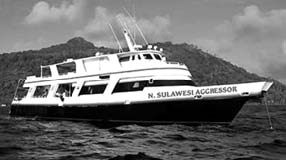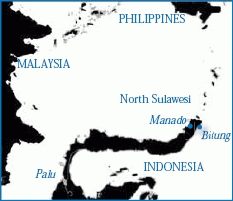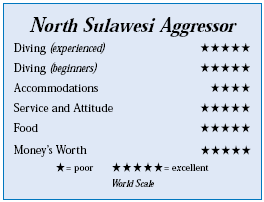North Sulawesi Aggressor, Sulawesi Sea, IndonesiaContents of this Issue: North Sulawesi Aggressor, Sulawesi Sea, Indonesia When Do You Need Dive Travel Insurance? Halcyon Recalls Explorer-40 BCs The Worst Job in the Diving World CDs: The Ideal Surface-Detection Aid? When Bad Things Happen to Good Divers Editorial Office: Ben Davison Publisher and Editor Undercurrent 3020 Bridgeway, Suite 102 Sausalito, CA 94965 mucking about for critters from the February, 2007 issue of Undercurrent
Dear Reader: During my seven-day dive trip on the North Sulawesi Aggressor, I saw more new critters than in all my decades of diving. Muck diving in murky, garbage-filled water is like poking through a landfill, but hiding in that trash are some of the most exotic jewels in marine life. For example: Two inch-long, flamboyant cuttlefish having a spat in open water, while four others fed in a nearby whip coral, their flashing long white tongues almost the size of their bodies. Beautiful and vibrant Coleman shrimp hiding among pink and orange fire urchins marching in formation like troopers. A spotted-tail sole lying buried in the sand next to a Napoleon snake eel, with only its colorful snout peering out of the sand.
My group of 16 divers from the U.S., England, Jakarta, and Germany chartered the entire 18-passenger, eight-stateroom boat and filled all beds, with the exception of two in a quad room. The Aggressor’s week-long charters depart from the dock of Kungkungan Bay Resort near the city of Bitung on Sulawesi’s northern coast. Instead of packing my dive gear and hanging around for the 5 p.m. boarding time, I enjoyed a day touring the Highlands’s coconut plantations and rice paddies while the KBR resort staff schlepped my baggage and gear to the Aggressor.
The Aggressor has only been operating in Sulawesi since October 2005. The steel-hulled boat, formerly used as an oil carrier in the Gulf of Mexico, is carpeted from wall to ceiling to minimize noise. Still, the folks with cabins in the bow could hear the anchor rolling up and down, and I heard the roar of the engine from my room near the stern on the several mornings we made an early departure. After our first day in Lembeh Strait, we headed north to Bangka Island to spend a day diving the reef wall and seeing more pristine corals. Unlike the calm but murky Strait, Bangka Island had wavy surface conditions, shifting currents and visibility sometimes as far as 100 feet. The crew had seen mating blue ring octopuses several weeks prior so we made three dives at Batu Mandi. While I saw no octopuses, I did see a large egg cowrie with its black mantle spread over a sponge, a thorny scallop-size oyster, and a flame file clam feeding on the wall. The dive deck is spacious, perfect for a giant stride into the water, and holds a toilet and two showers. A large camera table is surrounded by individual port and starboard benches with tank holders. My seat opened up with a bin for gear storage. Rinse tanks are designated for either gear or cameras. Almost everyone had at least one camera, and four divers had laptops, so the 110-volt camera charging outlets lining the salon wall came in handy, with more available for computers near a table in the upper salon. The two 16-foot, custom-made fiberglass skiffs, with blue awning covers for shade protection, were always used for drift diving. They also have tank holders for the aluminum 3000s, with gear space under the seat and a carpeted bench for cameras. The boat used air or Nitrox lines directly to the tanks geared up in the skiffs, and my tank was refilled almost before I undressed after each dive. All I had to do was don my three-mil suit and hand a crew member my camera, which they loaded onto a carpeted ledge near the stern of the skiff. At the end of each day, I passed up my fins and mask as the crew moved the aluminum 3000 tanks onboard. Each of the eight compact staterooms have a sink and vanity, bunk beds, and a toilet with hot water shower. The wall-carpeted room I shared with a friend was probably the smallest one, and without any drawers, I had to store my suitcases under the lower bed and live out of them. Not very convenient. The air-conditioning thermostat was difficult to regulate -- my roommate was frequently too cold, I was too hot, or vice versa. I soaked up rays on the upper deck’s sundeck with lounge chairs and a Jacuzzi. It’s also where we enjoyed lunch. An open kitchen with two dining tables is on the main deck. It’s one step up to the upper salon to watch video entertainment, read, nap, or use the boat’s computer for email, $5 bucks a message. (Watch out if you do the latter: You have to enroll with SeaWave’s online service, and they continue to bill monthly unless you call to terminate service.) Alan’s crew provided excellent service. Coffee and cereal were served at 5 a.m. before the early morning dive, followed by a full breakfast of bacon or ham, eggs and pancakes. Sweet treats such as cinnamon rolls or brownies were served mid-morning as we climbed out of the water, and heavier snacks like fried shrimp or calamari were for post-afternoon dives. Dinner included salad, an entrée of chicken, fish, pork, or meat, plus an option for the vegetarians. Not every dish was cooked to perfection; the mashed potatoes were too sticky and there was often too much sauce on the chicken or pork. I often made a beeline to the more traditional Indonesian dish of tofu and vegetables. But dessert was irresistible -- fresh-baked cookies, cakes and rolls, and homemade ice cream. Dinner was served on linen tablecloth with beer or wine followed by an evening video show, but most passed on the wine with dinner because of the night dive and the “no drink and dive” rule. I typically dived four dives during the day, plus the night dive. The minimum hour-long plan for each dive was loose because all the dives were 40 to 60 feet. Nitrox was available, but I didn’t need it for shallow dives. The ocean and nighttime air were typically a comfortable 81 degrees. At 3:30 one morning, the boat lifted anchor to be the first to arrive at Bunaken Manado Tua Marine National Park. Here I saw ambon scorpionfish, crocodile fish, orangutan crabs hiding in bubble coral, schools of bumphead wrasse and tuna, and an eagle ray. The sites were typically only three to five minutes away by skiff from the mother boat. Entry is a backward roll, and in wavy conditions, a direct descent. After each dive, the crew passed me a paper cup of water with a bowl or pineapple and papaya. They also spotted me as I climbed from the skiff to the Aggressor, insisting I use two hands to climb up and down the ladder. Otherwise, I was treated like an experienced diver. There was no checkout
dive since we spent the first day in Lembeh Strait, which is easy and shallow
diving. Because most of the dive sites are similar, on reefs with either 75-foot
visibility or dense muck, the focus was on finding critters rather than cruising. We divided randomly into groups of eight and usually alternated dive sites. On a few occasions, we were dropped at different locations on the same site. It was never crowded unless we all hovered for a shot at a critter. Some divers flipped out when they saw the rare mimic octopus in shallow rubble at Teluk Lekaus near the harbor town of Manado. The stunning sheer wall was lush with coral. A pair of green turtles swam off but a bumphead stayed long enough for a photo op. I caught a brief glimpse of the shy, skittish bumblebee shrimp as it scampered into a hole. I also found a rare purple Rhinopias scorpion fish in deeper water, its intense color fading into a dull hue when cameras flashed. I did a wreck dive at Kapat Rusak. Decades of coral encrustment and the history of a Japanese invasion of Sulawesi during World War II lend credence to it being a warship. We were required to state our depth and bottom time when we returned to the boat, which Captain Niall said was to keep a record of our profiles in case we had medical problems. I think that translated into, “We have a record of your stated profiles in case you sue us for DCS.” He also was firm that if we blew our computer deco time, we were out of the water for a minimum of 24 hours. Niall was recovering from a nasty hand infection and therefore unable to dive with the underwater videocamera. To make up for not filming the customary video of our week, he gave everyone a complimentary highlight video of Sulawesi’s critters, plus still photos. As the days passed, the group caught my fever for getting at least a glimpse of the blue ring octopus so at our request, the Aggressor returned to Batu Mandi. We searched a shallow 20-foot rubble site with supposedly good viewing opportunities. No such luck. Heading back on our final day, we stopped midway in the Strait for some wall diving. At Angel’s Window, I finally got to see two octopuses frolic. They were no blue rings, but it was still thrilling to see their bright reddish- brown bodies, white-marked waving tentacles, and stalked horn-like appendage eyes. Overall, the muck produced more critters than I had ever imagined. My divemasters were eager to point them out, but would frequently spend too much time in one area, then zigzag off in another direction. When the visibility was low (20 to 30 feet), I was frequently on my own. Several times, I lost the group when I stopped for a photo. For a mixed or less experienced group, critter sightings and dive plans can only improve as the Aggressor spends more time in Sulawesi and becomes more familiar with the area and its creatures of the muck. However, nearly all the muck sites are easily reached by land-based boats, so one can cover that terrain for far less than the Aggressor charges. In next month’s issue, we’ll highlight dive resorts on the Lembeh Strait. --A.P.
|

I want to get all the stories! Tell me how I can become an Undercurrent Online Member and get online access to all the articles of Undercurrent as well as thousands of first hand reports on dive operations world-wide
| Home | Online Members Area | My Account |
Login
|
Join
|
| Travel Index |
Dive Resort & Liveaboard Reviews
|
Featured Reports
|
Recent
Issues
|
Back Issues
|
|
Dive Gear
Index
|
Health/Safety Index
|
Environment & Misc.
Index
|
Seasonal Planner
|
Blogs
|
Free Articles
|
Book Picks
|
News
|
|
Special Offers
|
RSS
|
FAQ
|
About Us
|
Contact Us
|
Links
|
3020 Bridgeway, Ste 102, Sausalito, Ca 94965
All rights reserved.


 Jovial captain Niall Lawlor is an enthusiastic,
redheaded Irishman who has been with
the Aggressor fleet for almost a dozen years,
navigating around Honduras, Palau, the Solomon
Islands and Chuuk. Besides giving a short
safety briefing and checking C and Nitrox cards, Niall also repaired any ship
problems (the engineer was on vacation), presented evening slide shows and poured
the dinner wine. But Niall draws the line at cooking; that job belongs to his
brother, Alan. Taskmaster Kurt Jensen was as officious as a drill sergeant, but
he seemed to warm up after a few days responding, “Yes, Sir!” with a salute. Most
of the eight-person Indonesian crew, excluding the divemasters, spoke only a few
words of English, but they were friendly, hard-working and efficient.
Jovial captain Niall Lawlor is an enthusiastic,
redheaded Irishman who has been with
the Aggressor fleet for almost a dozen years,
navigating around Honduras, Palau, the Solomon
Islands and Chuuk. Besides giving a short
safety briefing and checking C and Nitrox cards, Niall also repaired any ship
problems (the engineer was on vacation), presented evening slide shows and poured
the dinner wine. But Niall draws the line at cooking; that job belongs to his
brother, Alan. Taskmaster Kurt Jensen was as officious as a drill sergeant, but
he seemed to warm up after a few days responding, “Yes, Sir!” with a salute. Most
of the eight-person Indonesian crew, excluding the divemasters, spoke only a few
words of English, but they were friendly, hard-working and efficient.  Other than the name of the site, there
wasn’t the need for a formal briefing on
conditions and terrain. Having traveled on
other Aggressor fleet boats, I am sure that
if anyone needed hand-holding, the crew
would have done so.
Other than the name of the site, there
wasn’t the need for a formal briefing on
conditions and terrain. Having traveled on
other Aggressor fleet boats, I am sure that
if anyone needed hand-holding, the crew
would have done so. Diver’s Compass: Most of Sulawesi’s critters and corals sting and bite
... While the water temperature is warm, it’s wise to have 1- to 3-
mil coverage protection. The muck has lots of garbage and pollution, so
take caution with ears and eyes. Several divers on my trip got infections.
Sulawesi is not considered a malaria area. The country is predominantly Christian and the people are welcoming and friendly ... I spent five
days at Kungkungan Bay Resort, which was included in my package ... I flew the
nonstop Singapore Air flight for about $1200. The flight to Manado, booked through
Singapore Air, cost another $500. Get details at
Diver’s Compass: Most of Sulawesi’s critters and corals sting and bite
... While the water temperature is warm, it’s wise to have 1- to 3-
mil coverage protection. The muck has lots of garbage and pollution, so
take caution with ears and eyes. Several divers on my trip got infections.
Sulawesi is not considered a malaria area. The country is predominantly Christian and the people are welcoming and friendly ... I spent five
days at Kungkungan Bay Resort, which was included in my package ... I flew the
nonstop Singapore Air flight for about $1200. The flight to Manado, booked through
Singapore Air, cost another $500. Get details at 